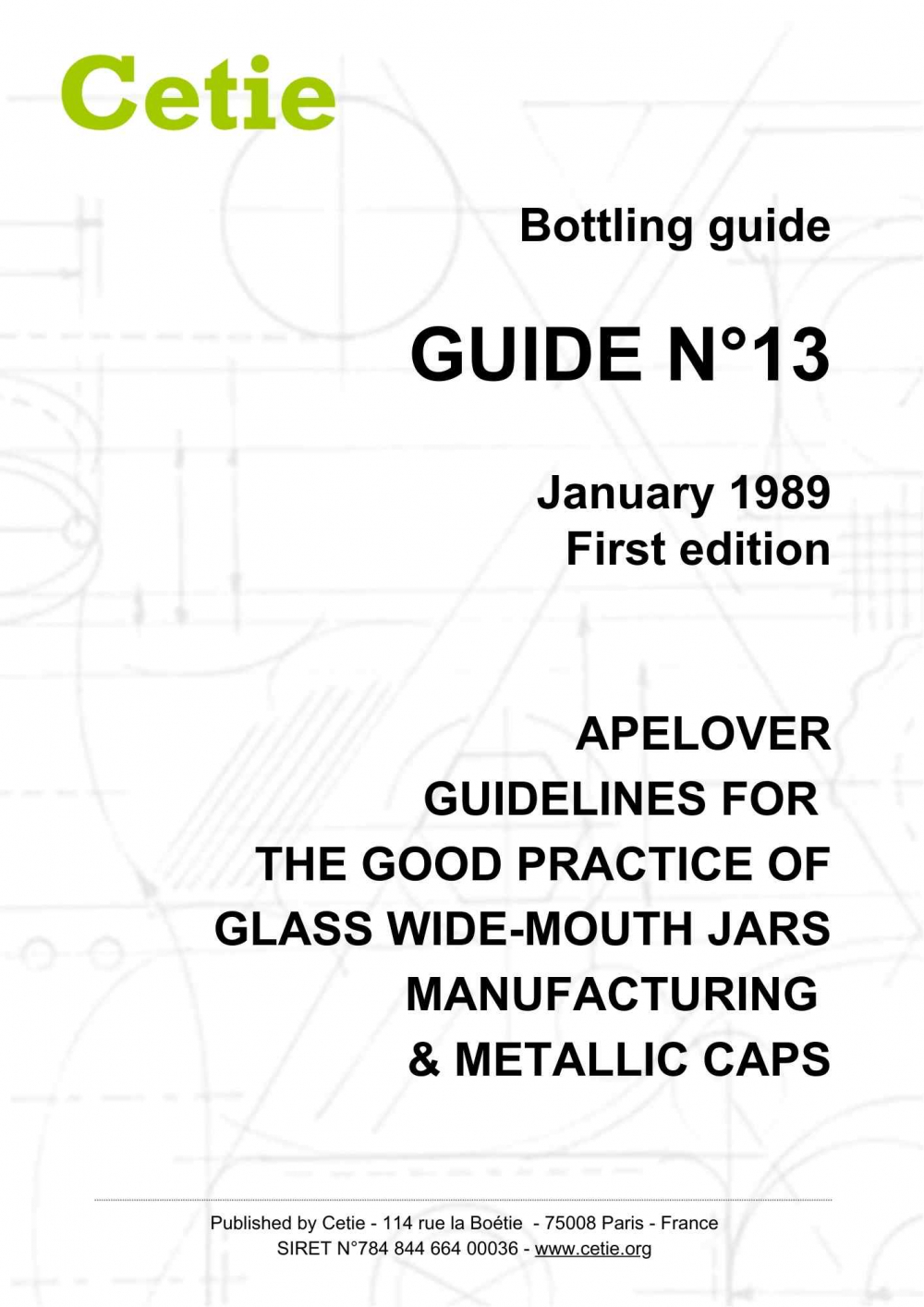Guide No.13
First edition
Published on: 01/01/1989
Apelover - Guidelines for the good practice of glass wide-mouth jars manufacturing & metallic caps
Scope of application
Every stage in the packaging of a product is part of good manufacturing practice, in the same way as its production.
The correct use of industrial glass jars and metal capsules is part of this principle.
It enables these two complementary elements to fulfill their protective packaging role to the full. This guide, which does not claim to be exhaustive, sets out the main rules to be observed.
As you will see, they are pragmatic and simple to implement. This document should not be considered as a regulatory text, but as a very general guide that can be adapted in certain specific cases.
The correct use of industrial glass jars and metal capsules is part of this principle.
It enables these two complementary elements to fulfill their protective packaging role to the full. This guide, which does not claim to be exhaustive, sets out the main rules to be observed.
As you will see, they are pragmatic and simple to implement. This document should not be considered as a regulatory text, but as a very general guide that can be adapted in certain specific cases.
Table of contents
1 Introduction
1.1 Scope of the guide
1.2 Units
2 Industrial glass jars and metal caps - General
2.1 Industrial glass jars
2.1.1 Definition
2.1.2 Characteristics and properties
2.1.3 Packaging
2.2 Metal caps
2.2.1 Definition
1.1 Scope of the guide
1.2 Units
2 Industrial glass jars and metal caps - General
2.1 Industrial glass jars
2.1.1 Definition
2.1.2 Characteristics and properties
2.1.3 Packaging
2.2 Metal caps
2.2.1 Definition
2.2.2 Characteristics and properties
2.2.3 Description
2.2.4 Packaging
3 Recommendations on the utilisation of industrial glass jars and metal caps
3.1 Transport and storage of empty jars and caps
3.1.1 General
3.1.2 Particular pre-storage precautions
3.2 Utilisation of empty jars and caps
3.2.1 Empty jars
3.2.2 Depalletisation - Handling
3.2.3 Caps 3.3 Filling
3.3.1 Precision of filling
3.3.2 Filling temperature
3.3.3 Cleanliness when filling
3.4 Closing
3.4.1 Vacuum closure
3.5 Specification of the utilisation of the caps and cap application equipment
3.6 Post-closure inspections
3.7 Marking
3.8 Washing full jars
3.9 Treatments
3.9.1 Preliminaries
3.9.2 Choice of heat treatment
3.10 Drying full jars
3.11 Final closure inspections (see table, page X)
3.12 Handling and packaging full jars
3.12.1 General
3.12.2 Palletisation
3.12.3 Boxing
3.12.4 Shrink filming
3.13 STORAGE
3.13.1 Temperature
3.13.2 Condensation
3.13.3 Absence of Aggressive Agents
3.13.4 Mechanical stress during storage
4 Bibliography
4.1 Preserves technology
4.2 Characteristics of packaging
5 Cross-related documents
6 Document history
Index of Figures
Index of Photos
?Index of Tables
2.2.3 Description
2.2.4 Packaging
3 Recommendations on the utilisation of industrial glass jars and metal caps
3.1 Transport and storage of empty jars and caps
3.1.1 General
3.1.2 Particular pre-storage precautions
3.2 Utilisation of empty jars and caps
3.2.1 Empty jars
3.2.2 Depalletisation - Handling
3.2.3 Caps 3.3 Filling
3.3.1 Precision of filling
3.3.2 Filling temperature
3.3.3 Cleanliness when filling
3.4 Closing
3.4.1 Vacuum closure
3.5 Specification of the utilisation of the caps and cap application equipment
3.6 Post-closure inspections
3.7 Marking
3.8 Washing full jars
3.9 Treatments
3.9.1 Preliminaries
3.9.2 Choice of heat treatment
3.10 Drying full jars
3.11 Final closure inspections (see table, page X)
3.12 Handling and packaging full jars
3.12.1 General
3.12.2 Palletisation
3.12.3 Boxing
3.12.4 Shrink filming
3.13 STORAGE
3.13.1 Temperature
3.13.2 Condensation
3.13.3 Absence of Aggressive Agents
3.13.4 Mechanical stress during storage
4 Bibliography
4.1 Preserves technology
4.2 Characteristics of packaging
5 Cross-related documents
6 Document history
Index of Figures
Index of Photos
?Index of Tables
History
First edition: 01/1989
First edition: 01/1989
Contributors
CEBAL, MASSILLY, SAINT GOBAIN EMBALLAGE
Document under responsibility of working group:
Glass wg1+4
WG chair: Arnaud JANIN - VERALLIA FRANCE
This permanent group is dedicated to a wide range of topics downstream of the production of glass bottles and jars dedicated to the food and beverage industries:
- Surface treatments, marking, labelling;
- Testing methods (impact, headspace, internal pressure, etc.);
- Nomenclatures (of finishes, jars, bottles, and visual defects, etc.);
- Quality management (food and beverage safety, best practices, regulations).
